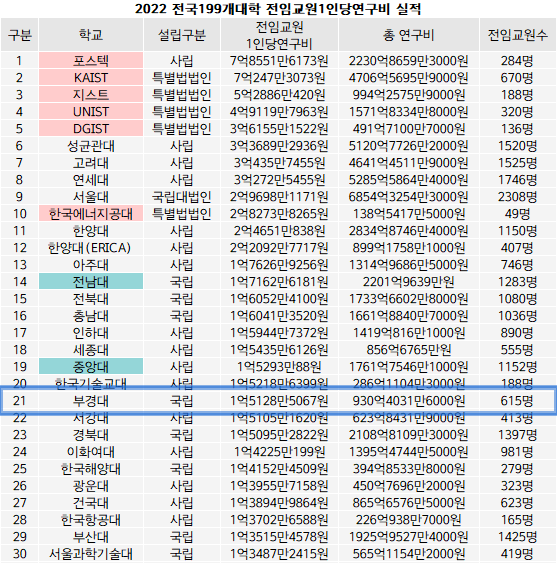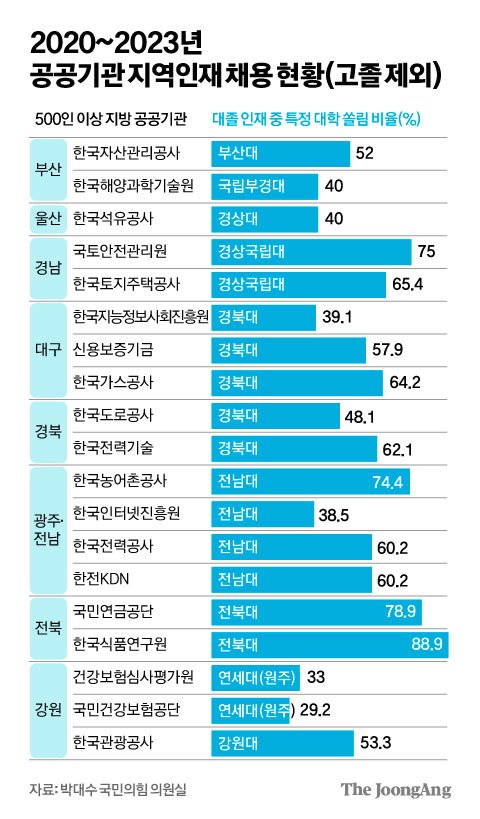커뮤니티
부경투데이
- 국립 부경대학교의 다양한 모습과 소식을 접하시면 부경대학교가 한번 더 가까워집니다.
| 창학 100년의 힘 | 데이터로 본 부경대학교(PKNU through data) | |||
| 작성자 | 대외협력과 | 작성일 | 2023-09-25 |
| 조회수 | 1509 | ||
| 창학 100년의 힘 | 데이터로 본 부경대학교(PKNU through data) | |||||
 |
대외협력과 |  |
2023-09-25 |  |
1509 |
전임교원 1인당 연구비 부산 1위 … KIOST 채용 40%가 부경대 출신
- 각종 데이터에 나타난 부경대 위상 ‘주목’

최근 대학 관련 데이터를 다룬 언론 보도 등에서 부경대학교의 위상이 두드러져 눈길을 끈다.
대학 전문 매체 <베리타스알파>는 9월 22일 ‘연구비 1위 서울대 6854억 … 연대 성대 KAIST 고대 톱5’라는 기사를 냈다.
지난 8월 공시된 대학알리미 2022년 연구비 수혜실적 자료를 분석한 이 기사는 지난해 전국 대학 연구비 실적 1위는 서울대(6854억 원), 2위는 연세대(5285억 원), 3위는 성균관대(5120억 원)라고 밝혔다.
부산에서는 부산대(1925억 원)가 가장 많았고, 부경대(930억 원)가 그 뒤를 이었다.
이는 해당 대학의 전체 연구비로 비교한 것이다. 그런데 전체 연구비가 아닌, 전임교원 1인당 연구비 수주액을 따지면 각 대학의 실질적인 경쟁력이 드러난다.
전체 연구비를 전임교원 1인당 연구비로 계산해 보면, 전국 1위는 포스텍(7억8551만 원), 2위 KAIST(7억247만 원), 3위 지스트(5억2886만 원)로 순위가 바뀐다. 부산지역 순위도 부경대(1억5128만 원)가 1위, 부산대(1억3515만 원)가 2위로 뒤바뀐다.
전체 연구비는 부산대가 많지만, 전임교원은 부경대가 615명, 부산대가 1425명인 까닭에 1인당 연구비는 부경대가 더 많은 것이다. 더 작은 규모로 더 큰 성과를 낸다는 의미다.
이와 함께 9월 20일에는 <중앙일보>에 ‘합격자 89%가 한 대학 동문 … 너무 쏠린 ’공공기업 지역인재‘라는 기사가 실렸다.
이 기사는 지방의 우수 인재를 활용하기 위한 지역인재 채용으로 공공기관에 특정 대학 쏠림 현상이 심화하고 있다는 현상을 지적하고 있는데, 이는 해당 대학이 공공기관에 그만큼 많은 합격자를 배출한다는 것을 의미한다.
기사는 2020년부터 2023년까지 500인 이상 지방 공공기관의 지역인재 채용 현황을 지역별로 분석했고, 부산에서는 부산대와 부경대의 자료가 공개됐다.
자료에 따르면 한국자산관리공사 합격자의 52%가 부산대 출신이었고, 한국해양과학기술원(KIOST) 합격자의 40%가 부경대 출신인 것으로 나타났다.
이는 해양수산 분야 특성화를 바탕으로 관련 연구원, 공공기관 등에 많은 인재를 배출해 온 부경대의 역량이 반영된 것으로 분석된다. <부경투데이>

The research subsidy per full-time faculty ranked 1st in Busan, 40% of KIOST recruits are from PKNU
- The status of PKNU as shown in various data is attracting attention
Pukyong National University's status stands out in recent media reports covering university-related data, attracting public attention.
Veritas-α, a university media, published an article on September 22, 'Seoul national university ranked first in research funding with 685.4 billion won, Yonsei, Sungkyunkwan, KAIST and Korea university in the top 5'.
The article, which analyzed research grant performance data for 2022 published in University information last August, stated that Seoul national university (685.4 billion won) ranked first in research subsidy nationwide last year, Yonsei university (528.5 billion won) ranked second, and Sungkyunkwan university (512 billion won) ranked third.
Pusan national university had the most (192.5 billion won) in Busan, followed by Pukyong National University (93 billion won).
This is compared to the total research budget of the university. However, the actual competitiveness of each university can be derived by considering the amount of research funding received per full-time faculty member, rather than the total research budget.
When calculating the total research expenses per full-time faculty member, the ranking changes to POSTECH (785.51 million won) in first place, KAIST (702.47 million won) in second place, and GIST (528.86 million won) in third place. The rankings within the Busan region are also reversed, with Pukyong National University (151.28 million won) ranked 1st and Pusan National University (KRW 135.15 million) ranked 2nd.
Pukyong National University receives a lot of overall research funds, but because Pukyong National University has 615 full-time faculty members and Pukyong National University has 1,425 full-time faculty members, the research expenses per one person are higher at Pukyong National University. This means achieving greater results with a smaller number of people.
In addition, on September 20th, an article was published in <JoongAng Ilbo> titled '89% of successful applicants graduated from one university, too much focus on 'local talent in public enterprises’.
This article points out that the concentration of certain universities in public institutions is deepening due to the recruitment of local talent to utilize local talent, which means that specific universities produce many successful applicants to public institutions.
The article analyzed the local talent recruitment status of local public institutions with more than 500 employees from 2020 to 2023 by region, and in Busan, data from Pusan national university and Pukyong National University were released.
According to the data, 52% of the successful applicants to the Korea asset management corporation were from Pusan national University, and 40% of the successful applicants to the Korea institute of ocean science & technology (KIOST) were from Pukyong National University.
This can be analyzed as a reflection of Pukyong National University's competence of fostering many talented people in related researchers and public institutions based on its specialization in the marine and fisheries field. <Pukyong Today>